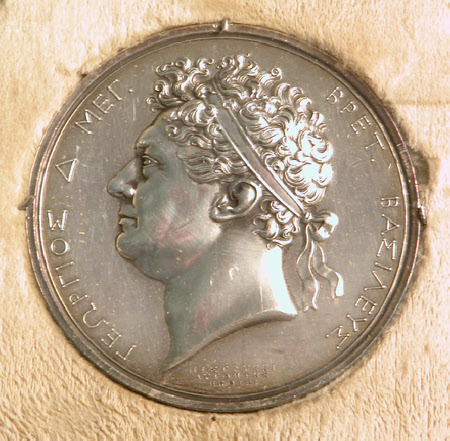Laudatory Medal of King George IV
Benedetto Pistrucci (Rome 1783 - Windsor 1855)
Category
Coins and medals
Date
1824
Materials
Silver
Measurements
61.5 mm (Diameter)
Place of origin
London
Order this imageCollection
Anglesey Abbey, Cambridgeshire
NT 517662.11
Summary
Silver, Laudatory Medal of King George IV, Benedetto Pistrucci (1783-1855), London, 1824. A portrait medal in silver of King George IV (1762-1830, reigned 1820-30), made in 1824 by Benedetto Pistrucci (1783-1855). The medal, known as the Laudatory Medal of George IV, depicts on the obverse the profile portrait of the king facing left, his hair held by a ribbon, tied at the back. The legend in Greek, translatable as ‘George IV, King of Great Britain’ with, below the bust, the artist’s signature in Greek, ‘Done by Pistrucci from the Life’. On the reverse there is the head of a trident, flanked by two dolphins and, either side of the column-like trident handle, the date in Greek letters, 1824. Mounted in a frame with ten other medals and tokens commemorating and celebrating King George IV (NT 517662).
Full description
It is not known for what occasion this superb medal was made. It has been suggested that because the lettering is in Greek, it commemorated ‘Naval Aid to Greece’, a title that was at one time given to it. However, there is no record of any such assistance being rendered by the British to the Greeks in the year 1824. The design is remarkable for its bold neo-classicism, both the portrait of the monarch, which recalls the images of rulers on ancient Greek coins, and the stylised dolphin and trident design on the reverse. The portrait of the king is close to a cameo portrait by Pistrucci in the Fitzwilliam Museum, made in 1817-20, when George was still Prince Regent (Milano 2006, pp. 20-21, no. 10). Two wax models for the portrait are in the Museo della Zecca di Roma, in Rome (Pirzio Biroli Stefanelli 1989. I, pp. 104-05, nos. 42-43). The medal was made by Rundell, Bridge and Rundell in gold, silver and bronze versions. Benedetto Pistrucci was one of the most brilliant gem engravers of the first half of the nineteenth century. Born in Rome, following a short period in Paris, he arrived in 1814 in London, where he quickly found important new patrons, including William Wellesley-Pole, Master of the Royal Mint. Pistrucci caused a stir in London by claiming that a cameo with the head of Flora, bought by the connoisseur Richard Payne Knight as a rare Roman antiquity, was in fact his work. In 1816, Pistrucci began to work at the Royal Mint on new designs for gold and silver coinage, including his famous reverse of Saint George and the Dragon, created for the new gold sovereign of 1817, and still in use to this day. On the death of Thomas Wyon in September 1817, Pistrucci became in effect Chief Engraver although, as an alien, he was not permitted officially to hold the title. He made the official medal for the 1821 Coronation of George IV (see NT 517662.3, 6 and 7), this commission following that for his most ambitious medallic project, the Waterloo Medal (Brown 1980, no. 870; Eimer 2010, no. 1067). The artist’s signature inscription, ‘Done by Pistrucci from the Life’, is significant in this context, since it would seem to refer to an incident a few years earlier, when the Prince Regent had sent a portrait of himself by Sir Thomas Lawrence to Pistrucci, asking him to copy it for the obverse of Pistrucci’s masterpiece, the Waterloo Medal. Pistrucci flatly refused to abandon his lifelong principle of never copying another artist’s work. Thus a few weeks later the Master of the Mint, William Wellesley Pole, was horrified on visiting Pistrucci’s studio to find not only that no work had been done on the portrait of the Prince Regent, but that Lawrence’s picture had been put aside, its face to the wall. Eventually Pistrucci was granted the life sittings with the Prince that he had demanded, and to which the superb portrait on this medal bears witness. Jeremy Warren, 2020
Provenance
Bequeathed to the National Trust by Huttleston Rogers Broughton, 1st Lord Fairhaven (1896-1966) with the house and the rest of the contents in 1966.
Credit line
National Trust Collections (Anglesey Abbey, The Fairhaven Collection)
Marks and inscriptions
Obverse: Legend: ΓΕΩΡΓΙΟΣ Δ ΜΕΓ . ΒΡΕΤ . ΒΑΣΙΛΕΥΣ [GEORGIOS D MEG BRET BASILEUS] Artist’s signature below bust truncation: ΠΙΣΤΡΥΚΚΙ/ΑΥΤΟΠΤΗΣ/ΕΠΟΙΕΙ [PISTRUKKI/AUTOPTIS/EPOIEI] Reverse: Inscription: ΑΩΚΔ [AOKD]
Makers and roles
Benedetto Pistrucci (Rome 1783 - Windsor 1855), medallist
References
Weber 1894: Frederick Parkes Weber, ‘Medals and Medallions of the Nineteenth Century, relating to England, by foreign Artists. Part II’, The Numismatic Chronicle and Journal of the Numismatic Society, Third Series,Vol. 14 (1894), pp. 101-178, p. 115, no. 191 Brown 1980: Laurence Brown, A catalogue of British historical medals 1760-1960, Vol.I. The accession of George III to the death of William IV, London 1980, p. 298, no. 1221 Stefanelli 1989: Lucia Pirzio Biroli Stefanelli, Roma, Museo della Zecca. I Modelli in Cera di Benedetto Pistrucci, 2 vols., Rome 1989, Vol. I, p. 34, no. 5; pp. 104-05, note 2 Milano 2006: Carlo Milano, Pistrucci’s Capriccio. A rediscovered Masterpiece of Regency Sculpture (ex. cat.), London 2006; venue: Sir John Soane’s Museum and Waddesdon Manor 2006, p. 21, no. 11 Eimer 2010: Christopher Eimer, British Commemorative Medals and their Values, London 2010, p. 163, no. 1171, Pl. 128
